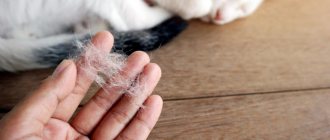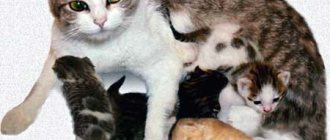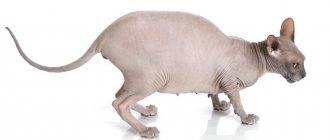It’s not difficult to bring a British cat into your home: you need to go to the nursery’s website, choose the beauty you like, and get recommendations for care. But not everyone can provide an animal with decent living conditions. You need to learn to become a pet's friend, assistant, and sometimes a doctor.
Puberty
British cats are called late breeders. Their puberty can take up to 11 months: each animal has its own developmental path. On average, plush pets mature at the age of 1 year. But in some children, initial signs appear at 4-5 months.
Estrus
The first heat of a British cat, according to the observations of British owners, begins at 7-9 months. During this period, inexperienced owners are lost and do not know what and how to help the animal. The cat screams, arches its back, raises its tail, and becomes restless. Experienced breeders know how long estrus lasts in cats of the British breed: it can last about 3 days to a week.
Recurrence of symptoms can be observed after 2 weeks if the animal is not taken for mating. The giving birth adult asks for attention from the male every three months. Don’t be afraid: the clinic’s specialists will explain how often British cats go into heat, or you can ask the owner of the cattery for advice.
It happens that the baby refuses to eat, loses weight, sheds intensely, and organizes concerts at night. Both the animal and family members suffer. Therefore, when planning to buy a British cat, you need to immediately decide: the pet is being taken for breeding or the owner does not intend to breed and, in the future, sell kittens.
What other signs can you use to find out about pregnancy?
Sometimes even a pregnant British cat can go into heat. However, the animal bearing the cubs does not pay any attention to the cats at this time. Also, pregnancy in a British woman can be determined by her changed behavior. The cat not only sleeps constantly, but also becomes very affectionate. The animal rubs itself at the feet of its owners, asks to be held, purrs loudly, etc.
Determining pregnancy in a British cat is relatively easy. However, to be absolutely sure of this, animal owners should still visit a veterinarian. After the examination, the doctor will be able to say for sure whether the cat is carrying cubs or not.
Prematurity or postmaturity
The average gestation period for representatives of a British, Scottish Fold or other breed can last 63-66 days or 9 weeks. But sometimes, due to a very young body or for other reasons, your cat begins to give birth earlier than expected.
If this happens at the initial stage, then due to the immaturity of the embryo, this moment is not always noticed by the owner. At 3-6 weeks, when the possibility of miscarriage is most likely, this happens due to improper care of the pet. Therefore, it is necessary to constantly monitor the British cat.
And when you want to pick her up, you need to do it carefully, holding her by the front legs and holding her butt, in order to secure the unborn kittens. To avoid post-term pregnancy, it is necessary to calculate the pregnancy of a British cat by week.
Thanks to this, you can accurately determine when your animal is due to give birth. And if labor is delayed, the first step is to contact a veterinarian so that he can provide appropriate assistance.
To avoid post-term pregnancy, it is necessary to calculate the pregnancy of a British cat week by week. Thanks to this, you can accurately determine when your animal is due to give birth. And if labor is delayed, the first step is to contact a veterinarian so that he can provide appropriate assistance.
There comes an exciting moment in the lives of many owners when their furry pet is ready to become a mother. Natural questions arise that not every owner can answer. How does a British cat’s pregnancy proceed, how many weeks does she carry kittens, how to properly prepare for childbirth at home, and how to identify signs of pregnancy in a “British cat”?
We will try to answer these and other questions in this article.
It is important to keep in mind that the pregnancy of a British cat is similar to the pregnancy of many other breeds popular with breeders.
Mating
Only purebred animals can be bred. The cat will not give birth: it is necessary to choose a doctor to sterilize the animal. Usually the procedure is performed after the end of the acute period of estrus. The client is given sedative drops to alleviate the condition. Important: do not use hormonal drugs that cause serious disturbances in your pet’s fragile body without a veterinarian’s prescription.
14 days before the event, it is necessary to give the cat anti-worm medications and check the pets for all necessary vaccinations. It is necessary to carry out hygiene procedures: trim the claws. It is not recommended to wash it just before mating: a household product will remove the natural odor of the animal.
When to breed
After the first heat begins, they skip another one and then only find a British cat for mating. It is forbidden to bring a gentleman without waiting for the right time, the third heat. The consequences of non-compliance with the rule are sad: a miscarriage may occur, kittens will be born weak or dead.
Choosing a partner
One of the important points in choosing a partner for mating is whether the British cat has experience. The animal must be suitable in age and size. External characteristics, color and color, advantages and disadvantages of the individual, compliance with the breed standard, take into account all the data. Pay attention to the absence of diseases in the cat; strong offspring are born from healthy parents. It is better to choose a cat from your club.
A British Shorthair cat should be bred to a British Shorthair cat. It is most often not recommended to take a long-haired cat for mating. In most structures, offspring are considered marriage. To participate in exhibitions, they will find out in which system the pet is registered.
How does mating work?
The successful outcome of mating British cats depends largely on the behavior of the girl. The fluffy beauty is taken to the male’s house, or to neutral territory. In his own home, the cat behaves more confidently, and the process will go faster.
If the ward does not like the partner, the mating does not work out. A girl can show aggression, bite a cat, scratch a person who is nearby. Such problems do not always happen, but they do occur during the first experience. And the owner must be prepared for such a situation and not leave his pet immediately after arriving at the British cat for mating.
When the female's behavior does not cause concern, it is necessary to leave the pets alone. The total period that animals spend mating lasts 2-3 days. After this time, the male usually loses interest in his partner.
How to determine pregnancy
The owner will find out whether there was a result during the meeting with the cat in 2-3 weeks. External signs of pregnancy:
- The nipples of your teddy pet enlarge, the color changes: the skin becomes bright pink.
- In the fifth week, the sides around the ribs become rounded and appetite appears.
- The weight of the expectant mother increases: this sign does not always indicate the presence of kittens in the stomach. Your cat may be bloated or gain weight due to an improper diet.
The surest way to determine pregnancy is to perform an ultrasound of the abdominal area. The doctor will tell you whether the fetus is visible and how many kittens a British cat can give birth to for the first time.
Not often, but there are cases of false pregnancy. The girl feels nauseous, loses activity, refuses to eat, or the baby’s taste preferences change. The owner, assessing the behavior of the pet, is confident in the positive outcome of the mating. But at the end of 2 months he will not see the long-awaited kittens. The causes of false pregnancy are stress and hormonal disorders. The doctor will examine the pet and determine the animal’s condition.
Three trimesters
Like women, pregnancy in cats is also divided into three trimesters, each of which undergoes its own important changes. Folds change during this period, so special care is important for them. We are talking not only about the nutrition of pregnant women, but also many other things that deserve attention.
So, the trimester is divided as follows:
- 1-3 weeks (first);
- 3-6 weeks (second);
- 6-9 weeks (third).
First trimester
In the first week, the cat’s behavior shows practically no signs of itself. A healthy animal is active and cheerful. From the second week, it may begin to sleep more and refuse to play. Obvious signs appear only in the third week. If you touch the nipples, you will notice that they are slightly rounded and change their color to bright pink. This is especially noticeable in young individuals who are faced with an interesting situation for the first time. Experienced breeders note that older cats often do not have this symptom. In addition, the purr can suffer from toxicosis, which lasts only a couple of days.
Second trimester
This trimester is the brightest of all. This is associated with obvious symptoms and changes in the cat’s behavior. The kittens in the mother’s belly can already be clearly felt, although their exact number is problematic to determine. Scottish and British cats become especially round at this stage, and the uterus is almost completely filled with fluid.
Third trimester
The seventh week is characterized by obvious changes, which is associated with the opportunity to feel the future babies. In addition, unborn pets are already beginning to move. Considering that the cat is becoming obese, it is difficult for her to walk, so she tries not to get up from her place once again. Cold and wayward animals become more affectionate and gentle. Many begin to poke at the owner and ask to be held.
Just before giving birth, a pregnant British cat walks incorrectly, its belly sags and its back seems to arch, which indicates an upcoming important event. In addition, you can pay attention to the animal’s anxiety. The purr can search for a place for hours, and then “nest” in it. Often preference is given to cabinets and beds.
If you don’t want your pet to give birth anywhere, it is advisable to put the cat in a box a week before giving birth and arrange it, showing the animal its place.
First signs
The pregnancy of a Scottish Fold cat must be determined in a timely manner.
The gestation period for babies will be about 65 days. The main thing is that they are born between 63–67 days. Then no deviations from the norm occur. But if the pregnancy lasts too long and the cat is still carrying her babies, you will need to see a specialist. That is why it is very important to record the first signs of pregnancy on the calendar and clearly define the timing. In this case, you will create comfortable conditions for the future woman in labor, and you will be able to prepare directly for childbirth without haste.
Pregnancy of a domestic Scot mostly includes three stages. At first, the pet develops toxicosis and often vomits. Don't worry if your cat even refuses her favorite treats during early pregnancy. As for any female, the process of bearing babies is stressful, so lethargy and weakened appetite are possible at first. You will soon notice that your cat's nipples have changed color slightly and become swollen.
Pregnancy can be diagnosed (in a veterinary clinic) 2 weeks after fertilization. After another couple of weeks, the cat’s appetite improves and it begins to gain weight. At this stage you can see how her tummy is rounded. You can determine the delicate situation of your pet without much difficulty if you take a closer look at her and the characteristics of her behavior. Once you have been able to identify the key signs, it’s time to provide proper care for your pet.
Having learned about her pregnancy, every woman will hurry to register so that an experienced doctor can monitor her condition and the development of the baby. After mating the cat, you must also contact the veterinarian so that he can create a card and track the progress of pregnancy. How can you tell if a cat is really going to become a mother?
We suggest you read: Is it possible to feed a cat before sterilization, the opinion of veterinarians
To do this, it is enough to observe her after mating. Your pet will become affectionate and calm, and will ask to be held in your arms as often as possible. Appetite begins to increase approximately two weeks after mating. Make sure that the food is as varied and of high quality as possible, because the development of babies and their subsequent health largely depends on this.
The development of the embryo goes through several stages in any living creature. In particular, in cats there are 5 main stages that must be successfully completed in order for healthy kittens to be born. Surely you will immediately want to know how long British pregnant cats walk. We'll get to that very soon.
The first stage is 20-25 days. By the end of this period, pinkish nipples are already clearly visible, but the increase in the abdomen is not yet obvious. On average, the volume of the abdomen increases by only one and a half centimeters; it becomes plastic to the touch. At the same time, the appetite grows day by day. In order to prepare in time for the upcoming birth, you need to know how long British pregnant cats walk. In total, the gestation period takes 64-67 days. The more kittens your cat carries, the faster the pregnancy will end.
During pregnancy, a cat sleeps a lot, becomes unusually affectionate and affectionate, but sometimes can show aggression towards its owners. She starts to eat more. By 4–5 weeks, pregnancy becomes noticeable. The cat's belly becomes rounded, the nipples swell and become pinkish in color.
Two weeks before birth, the babies begin to actively move in the mother’s body. This period is considered critical for the animal. Monitor your cat closely: if you notice bloody discharge, contact your veterinarian immediately. This may be a sign of danger to the health of cats and kittens. The owner needs to pay special attention to the proper nutrition of his pet; he needs to feed it more often from 3 to 5 times in small portions.
We suggest you read: Ascites in cats: symptoms and treatment of abdominal dropsy
One of the first signs of impending labor may be the cat's refusal to eat. The animal begins to worry and constantly walks around the apartment, looking for a secluded corner. The next sign is a sudden drop in the cat’s temperature, this is normal, which means the birth will take place without complications. And vice versa, if her temperature rises quickly (up to 41 degrees), this threatens complications during childbirth. Apparently, an inflammatory process is developing, in which case urgent intervention from a veterinarian is required.
It is not difficult to understand how many months a pregnant cat walks; generally, pregnant cats walk from 56 to 70 days. The period varies depending on the breed and does not depend on other factors. However, if a cat experiences severe stress during pregnancy, she may give birth earlier.
After mating, it is possible to determine if a cat is pregnant only after 3-4 weeks. Previously, it did not appear in any way. Some symptoms:
- The cat's behavior changes, it becomes cautious and less active.
- Sometimes nausea is observed, and temporary refusal of food is observed.
- Later, on the contrary, appetite increases. The animal eats a little, but often.
- If the cat is pregnant for the first time, changes in the nipples can be seen in the second month. They increase in size and swell. Now they can be easily felt.
- The belly gradually rounds and grows.
The animal becomes less active.
Not all cats will necessarily have the same signs. No two animals are the same, and their symptoms of pregnancy are different. Slender cats often give birth on time, while well-fed cats carry them to term. Also, the period depends on the number of fruits. If there are many of them, birth occurs later.
At a later stage, you can place your palm on the cat’s stomach and feel the kittens move. But you don’t need to put too much pressure on the stomach so as not to harm the offspring.
gestational age
How long a feline's pregnancy lasts depends on the breed and number of babies. The pregnancy of a British cat lasts 63-64 days, cubs born before 60 days are considered premature. Girls with a small weight can give birth to kittens at 60-61 days; large representatives (5-6 kg) often overstay their due date. Fold representatives walk as long as British cats do for the first time.
First weeks of pregnancy
At 3 weeks of pregnancy, the cat vomits and taste habits change. The animal eats little. During this period, the already capricious British become mischievous and offended. The previously active baby stops playing, hides from people, and looks for secluded places.
Second half of pregnancy
At the beginning of the fifth week, the cat develops an appetite. Small lumps can be felt in the abdominal cavity. At the end of the 7th week, active movement is observed. The fluffy ward is gaining weight, her gait becomes slow.
The animal sleeps long and often, prepares for childbirth, arranges a place for babies, and purrs loudly. The cat finds a suitable “nest” and begins to remove everything that bothers it. If a mother takes a fancy to a closet, she will throw out clothes and books from it. Or, on the contrary, it will crush rags.
General information about the duration of gestation
On average, the question “how long does a cat stay pregnant?” The most frequently heard answer is 2 months. However, this is a rather loose concept; some individuals barely carry their offspring to term for up to 60 days, and for some the process can last up to 70.
According to general estimates, the minimum gestation period for cats is from 56 to 60 days, the maximum normal is considered to be 71 days (some sources give 72 days). These are periods when the birth of viable offspring is allowed. Most often, 64-67 days (roughly rounded, it comes out to 9 weeks).
The entire “pregnant” period is conventionally divided into 3 phases of development, each of which on average includes 3 weeks.
1 phase
This period lasts from the moment of expected conception to 21 days. During this period, eggs are fertilized and embryos develop. By the 15th day, the embryo already becomes up to 1 cm in size, by the 18th day the paws appear, and by the end of the period the internal organs are already formed. It is in this phase that active pinking of the nipples is observed.
2 phase
During this period (from 22 to 42 days), the brain, skeletal structure, muscles and endocrine system are actively formed and developed. From this point on, the kittens are called fetuses, taking on the classic feline appearance with a clearly defined muzzle and genitals. Only after a month of pregnancy the cat’s belly begins to grow a little.
3 phase
On days 43-63 from the moment of conception, kittens, growing to 8-10 cm, acquire a tail and acquire a coat with a certain color. By the middle of the period, their size reaches 13 cm, by the 57th day they are already fully formed and developed babies who are ready to be born at any moment. The maximum size of a newborn depends on the constitution of its parents.
There are exceptions to all rules. The duration may vary depending on many factors:
- offspring of purebred individuals born before 60 days are most often non-viable,
- cats with a slender constitution (subtle) usually never go pregnant longer than 65 days (on average 60-65 days), and fat and well-fed ones usually carry a pregnancy and the period can reach 70-72 days,
- primiparous cats, especially those who become pregnant during their first heat before the age of 1 year, in most cases give birth earlier than the expected average period (up to 60 days). Kittens are not always born viable and are often weak and small. This is why experienced breeders do not recommend mating a cat to produce offspring during her first heat and before the age of one year.
- primiparous middle-aged cats bear their offspring somewhat longer than their female peers who have given birth,
- yard outbred cats bear less fruit than domestic and special breed cats. Sometimes healthy babies are born on the 55th day - this indicates better endurance and higher adaptability of street individuals compared to domestic ones.
- in a fold cat (British, Scottish), kittens are gestated for an average of 63-67 days, but almost never less than 60 days,
- cases of nursing up to 75 days have been recorded. The course of the entire period was without complications, and the newborns were all alive and well. The reasons for such a long but safe gestation are still a mystery to veterinarians,
- Pregnancy of the Maine Coon breed is usually longer than that of other breeds - up to 68 days or 9 full weeks + preparation for the birth of the cat herself,
- long-haired cats stay pregnant longer (up to 70 days) than smooth-haired or completely hairless cats (around 65 days),
- the fewer fruits there are in the litter, the longer the cat can go pregnant and, conversely, the more, the faster and more often the birth will occur before the due date,
- weather conditions affect the onset of labor - sudden changes in temperature and environmental humidity can suddenly trigger premature birth,
- The pregnancy of a Scottish cat is usually shorter than that of a British cat, in which the pregnancy period can sometimes increase to 70-72 days. Therefore, there is no clear answer to the questions of how long pregnancy lasts in a Scottish cat or how long pregnancy lasts in a British cat - variations in duration are present here too.
False pregnancy in British women
In straight-eared and fold-eared British cats, pregnancy usually occurs after the first mating. But sometimes, unfortunately, conception does not occur in such pets. In some cases, British women may also experience a false pregnancy. In this condition, the cat has all the external signs of bearing kittens. In this case, the animal sleeps a lot, eats, its nipples swell, and it becomes affectionate. However, the embryos in the British woman’s uterus do not develop.
This condition occurs much less frequently in cats than, for example, in dogs. But still, sometimes owners of British women encounter false pregnancies.
The causes of this condition in cats are most often hormonal imbalance and stress. Also, false pregnancy is relatively common in animals that are hereditarily predisposed to this or are overweight.
It will be quite difficult for a less experienced cat owner to distinguish a false pregnancy from a real one. That is why, when the first signs of pregnancy occur, it is advisable to show the British cat to the veterinarian.
Caring for a pregnant cat
A pregnant British woman requires increased attention from all family members. Knowing the reason why British cats do not like to be held, you can learn how to communicate with the animal during pregnancy. An aristocratic person in ordinary times does not always accept signs of attention from the owner. But while waiting for the babies, she becomes more affectionate, sometimes following on their heels, making loud rumbling sounds.
Proper nutrition
During pregnancy, it is especially important to provide adequate nutrition. The menu is more nutritious and varied. Divide the amount of food intake into 5 times. They use industrial food specifically for pregnant British cats, containing a vitamin and mineral complex. What to feed a pregnant British cat on natural food: be sure to include in the diet:
- Lean meat.
- Vegetables.
- Cereal porridge.
- Fish (no more than 1-2 times a week).
- Additionally, they buy a complex of vitamins.
- Eggs.
- Cartilages.
What do we have to do
For a successful result, for the appearance of healthy kittens and support for the animal, a number of measures are carried out:
- monitor the health of your pet: if there is diarrhea, increased body temperature, or the appearance of discharge, you should urgently contact a veterinary hospital;
- control the weight of the British: it is important not to overfeed the animal.
- arrange a convenient place for childbirth: a box, a crate. The cat is shown a place and placed on a bed;
What not to do
- do not pick up the baby. If the girl herself unexpectedly wants to be closer to the person, stroke carefully, without pressing on the abdominal area;
- do not allow the expectant mother to climb high, limit access to objects near the ceiling;
- do not allow yourself to arrange a place for childbirth: the animal will ruin linen and clothes;
- Do not prescribe medications to your pet; use medications only as prescribed by a veterinarian;
- exclude factors that traumatize the animal’s psyche: loud music, noisy outdoor games.
How to help a British woman during childbirth
So, immediately before giving birth, the owner should be patient and carefully monitor the behavior of the expectant mother. If a cat chases a person, cries or, on the contrary, purrs, licks the crotch, then kittens are on the way. Just in case, it is worth agreeing with the veterinarian about his consultations by phone or visiting the mother in labor (if something does not go according to plan). The owner will also need to prepare:
- Clean disposable wipes (clean dry cloth);
- Vaseline or fatty cream;
- Cotton wool (or cotton pad);
- Scissors (preferably sterilized and treated with alcohol);
- Threads;
- Hydrogen peroxide;
- Hot water bottle with warm water;
- Clean water for cats to drink.
When your pet's amniotic fluid breaks or contractions begin, you should move her to a bed covered with a clean diaper (cloth). You can pet your pet and talk to her calmly. When contractions become frequent, and the cat begins to lick itself every now and then, it means that the first baby will soon be born.
To help a British female, you can gently stroke her belly (from the chest to the lower abdomen, pushing the babies towards the exit). If the kitten's head appears and the contraction has weakened, you can help by gently pulling the kitten by the skin in the withers area with a Vaseline-smeared hand. When the kitten's front paws appear, you should slowly pull him towards you by the body (very, very carefully, without grabbing his head or paws)
When the baby comes out, you should make sure that the placenta comes out (you can pull it out after the baby or wait until the cat pushes it out). For a newborn baby, it is necessary to cut the umbilical cord at a distance of 2-2.5 cm from the tummy, having previously tied it with a thread. Lubricate the kitten's navel with hydrogen peroxide. The newborn kitten should be placed closer to the mother so that the cat can lick the baby. If this does not happen, you should wipe the new family member with a napkin or clean cloth and place it close to the cat’s nipples so that he has a snack. Then the cat should be placed close to the heating pad, giving the cat the opportunity to give birth to the next baby.
Final stage
At the beginning of the 7th week, the pregnancy of a pet of the British breed has some peculiarities. In particular, you can feel the babies’ heads well and feel their movements. The cat's large size does not allow it to walk quickly , so it moves very slowly. The behavior of the British pet is also changing, which is expressed in greater attachment to its owner, the so-called “following.”
A few days before giving birth, anxiety appears in the animal's character, and the search for a place to give birth begins. Basically, it should be a secluded and cozy corner.
Most owners of British cats take a crate or box in which they need to create a place for small kittens and their mother.
A necessary point in this period of pregnancy is radiography and ultrasound. The purpose of this procedure is to study information about the number of fetuses and their placement in the uterus. And if some kittens are in the wrong position, then this will need to be taken into account during childbirth.
Childbirth
Before the onset of labor, a British cat restlessly follows its owner, meows anxiously, and licks its fur. You need to be especially careful the day before the expected event. Within 12-14 hours, body temperature begins to drop to 37.9 °C. Before labor begins, it is necessary to study the main stages of the birth of babies.
As soon as contractions begin, you need to put her in a prepared box with a clean diaper. The crumbs appear at intervals of 40-60 minutes. Kittens are born in a bubble. The mother chews the shell and licks the cubs: it stimulates the respiratory function of newborns. After this, the cat chews the umbilical cord. The animal most often eats the delivered placenta.
The birth process lasts from 2 to 14 hours.
Why might there be few kittens?
Having studied the question of how many babies British breed cats give birth to for the first time, you may not be surprised at the appearance of one baby from a young favorite. In the first litter, 1-3 cubs are usually observed.
Why can there be many kittens?
Multiple births are transmitted through the female line and depend on the number of previous lambings. An adult cat that has given birth can produce more kittens, 4-5. Especially if she herself appeared as a result of a multiple pregnancy.
Different kittens from the same litter
Genetically identical babies may differ in color. Babies receive a different set of genes from their parents, which is why different kittens appear from the same litter.
We deliver babies at home
As soon as the expectant mother’s water breaks, she needs to be moved to a pre-equipped bed, which should be covered with a clean cloth. It will be useful to calm the cat, because anxiety can lead to her screaming, biting and trying to run away from the birthing area. You need to pet her and talk to her (the calm voice of the owner best calms any pet).
When the cat begins to push, you need to place your palm under her hind legs so that she can rest. The best stimulation of labor, stroking the tummy and nipples. It is also worth allowing the newborn babies to suckle from their mother in the intervals between kittens coming out.
The interval between the release of kittens ranges from 15 minutes to several hours. Several babies may be born one after another, but the next ones may be born only after 4 hours or even more.
It is better when babies go forward with their heads. In the opposite situation, the baby's body may come out, but the head may remain inside the cat. In this case, you cannot pull the baby: you need to continue stroking the belly from top to bottom, stimulating her to push and pushing the kitten towards the light.
A newborn kitten is in a dark blue bubble, which should be cleaned in the area of the kitten's face so that it does not suffocate. Then the kitten can be placed next to the mother's head so that she can lick it. If the mother does not show any attention to the newborn, then you need to immediately clear the baby’s airways: for this you need to bring a compressed syringe to the baby’s nostril and then release it. Do the same with the other nostril.
When the baby comes out, you should use your fingers to drive the blood from the umbilical cord to the cat’s belly, and then cut it off with scissors at a distance of a few cm from the belly. Disinfect the cut umbilical cord with peroxide, and wipe the kitten with prepared dry wipes or a cloth.
If after this the baby actively moves and squeaks, then everything went well. If the kitten shows no signs of life, the resuscitation process must begin. You need to take the kitten in your hands and, holding its head between your index and thumb, shake it 2-3 times. Then you will need to rub the chest, blow into the nose and repeat everything in a circle for at least 5 minutes until the kitten shows signs of life. If he squeaks, he needs to be placed with his mother so that she can lick him. If the cat does nothing, then you should massage the baby’s anus with a cotton pad or a damp bandage, which will cause urination and defecation. If after 5 minutes of resuscitation the kitten still does not show signs of life, it means that it will no longer be possible to save it.
After each baby comes out, the placenta should come out. If after 12 hours the placenta has not come out, you should contact a veterinarian. It is normal for a cat to eat the placenta - after giving birth, she needs the nutrients that are in the placenta. You should not let her eat more than two afterbirths - this can lead to diarrhea.
You must remember to keep newborn kittens away from the cat’s paws, otherwise she may accidentally injure them. It is best to place them next to the new mother’s head on a warm heating pad so that they are always within the mother’s line of sight.
How long does a British cat's pregnancy last?
Animals of this breed do not carry their cubs for too long. Pregnancy in British cats usually lasts 9 weeks. During this time, a pet can bear 5-6 cubs.
After mating, eggs in a cat are formed during the first 23-30 hours. On average, there are usually about 6 of them. This is why cats, including British ones, usually give birth to many kittens.
What determines the timing of gestation in cats?
Pregnancy in a cat can occur after 6 months of age, when the first heat appears. The opinion of veterinarians on this matter is ambiguous, and most experts recommend not to give birth to your pet before she is 12–18 months old, because this is the most optimal age for fertilization and bearing healthy and strong kittens.
It is believed that cats with long hair and short hair have a significantly different gestation period. This opinion has no scientific evidence, but based on observations of long-haired pets during pregnancy, veterinarians noted that this period is slightly longer than that of short-haired pets. Gestation time reaches 72 days.
Shorthair cats remain pregnant for 59 to 65 days. Also, most representatives of the Siamese and Abyssinian breeds tend to bear future offspring longer than cats of other breeds.
If pregnancy is delayed, the cat should be shown to a qualified specialist.
So, if there are more than 5 kittens, labor begins a little earlier than expected. But if the time comes for the kittens to be born before the 58th day, and their number is more than 8, we can assume that they will be born dead.
Long-term pregnancy is observed in cats when there are no more than 3 kittens in the litter, and the animal is in a depressed state. However, if the timing is delayed by no more than 7 days, this is not a pathology, and kittens are born without any abnormalities.
If the pregnancy is delayed, far exceeding the upper limit of normal, you should show the cat to a qualified specialist who can help her. To do this, you need to know the exact day of mating of cats, because when fertilization occurs, the countdown of the pregnancy period begins.
Caring for a cat and kittens
The cat is provided with food and clean drinking water. The cubs are placed closer to the nipple, making sure that each receives a portion of milk. If the mother does not lick the babies after birth, they are wiped with a clean napkin.
What to do with kittens
In the first month, the mother cares for, raises, and feeds British kittens. Therefore, you should not remove crumbs from your cat ahead of time. Breast milk contains everything necessary for the development of babies.
Complementary feeding should be started carefully; dishes with food and water should be placed next to the bed. Children will learn nutrition and hygiene skills from an adult animal.
Growing up, puberty of a British cat, the appearance of offspring is a natural physiological process. But the life and health of pets depends on how a person behaves throughout this period.
Recommended reading: names and nicknames for British kittens
The birth of kittens
After the first kitten is born, cut the umbilical cord 2 cm from the tummy. Then tie it with thread and disinfect it. After this, you need to place the baby near the mother's nipples. This way she can lick him and feed him. The final stage for you: it is recommended to wipe the baby with a dry cloth after the first feeding. After this, place him on a warm heating pad. Do the same with the rest of the kittens.
When the due date comes, take care of the newborn babies and the mother in labor. Sometimes this process turns out to be difficult and lengthy, especially if the Scottish woman gives birth for the first time. Be patient and you can get beautiful Scottish kittens.
Labor begins with the breaking of grey-red water. It's time to urgently call a doctor if you want him to be present with you at the birth. The cervix and birth canal open. During this period, the cat usually begins to strain and her breathing quickens. If within 12 hours from the onset of these symptoms the kitten is not born, it is time to sound the alarm and save the cat’s life.
However, caesarean sections are not often resorted to. Usually the cat copes well on its own. The muscles contract and push the fetus into the vagina. If a cat gives birth for the first time, she can be very frightened, so it is important to be close to her, talk to her, and pet her. This will help her calm down and labor will go much faster.











